
Riveting from beginning to end. Christopher Nolan’s meticulous direction, casting, writing and character development in this taut tale of scientific, philosophical, and political intrigue is visually astonishing. Historically detailed, the film plays as a documentary-style feature film, shot in 70 mm for IMAX, demanding your attention for the entire 3 hours without it feeling overly long.
Nolan (Inception, Tenet, Dunkirk, The Dark Knight) based the screenplay on the book written by Kai Bird and Martin Sherwin. The multiple threads Nolan knits throughout the script all dovetail together to make a complete story. Truth is the crux of the political turmoil of the time post WW II after the defeat of the Nazis coupled with the coming Cold War and the hysteria over communism. The two main plot lines follow J.Robert Oppenheimer on the journey to creation of the A-Bomb and the aftermath following Hiroshima and Nagasaki. Then there’s the parallel thread of the power-hungry Lewis Strauss and his campaign to destroy Oppenheimer while he lusts after personal power and glory.
This film was shot in just 57 days which is extremely fast for a film of this length with so much dialogue. It’s a very tight script and we suggest you listen closely, because the interplay between the actors sometimes comes so fast, you can easily miss some of the best lines. It never gets wordy though there are important lines and ideas throughout that you have to listen closely to catch. We are going to make the 3 hour commitment to see it again, sure in the belief we’ll pick up on even more.
Cillian Murphy’s stoic and haunting persona of the brilliant, yet flawed scientist who had moral reservations about the atomic bomb make this film even more relevant now. Oppenheimer was cocky but brilliant, well educated, and spoke several languages. He was a sought after scholar at Berkley, Cambridge, Cal Tech, and also taught physics at Princeton where he became a director and department chair over Albert Einstein! Tom Conti is excellent as Einstein, shown passing worldly advice to Oppenheimer when he needed it most.

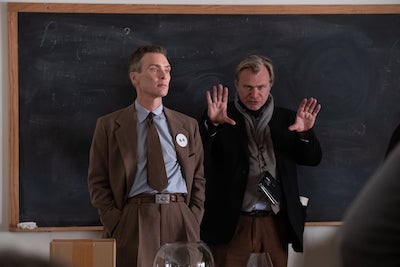
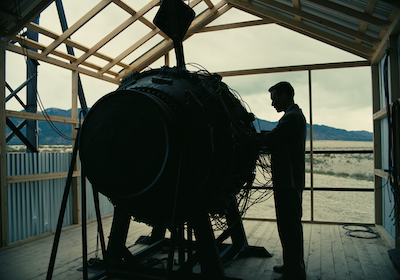
Murphy leads the way in this huge, superb cast who portray the real people affecting Oppenheimer’s life and work. They say Murphy pretty much kept to himself during filming, not joining the others in what became kind of a summer camp in New Mexico. Emily Blunt turns in a stern performance as Oppenheimer’s wife, Kitty. She was a respected biologist/botanist until, frustrated, she had to stay home with the kids in remote Los Alamos. She became an alcoholic, but also a security problem as a former member of the Communist party, which was an enormous red flag with American conservatives. Still, Blunt plays a smart respected woman who stands up for Oppenheimer when his past alliances and friendships are used to revoke the security clearance needed to continue working for the U.S. Government.
Robert Downey, Jr. takes a truly amazing turn in the very serious role of Lewis Strauss, the rich businessman and Chairman of the U.S. Atomic Energy Commission. The shots of Downey, Jr. as Strauss in black and white are especially effective making even more ugly the loathing he has for Oppenheimer. He is seething while displaying his calm, benign expression to those around him. Strauss does all he can to discredit Oppenheimer and his work. As the villain in this story, he secretly organizes the kangaroo court that strips Oppenheimer’s security clearance and helps telegraph the well-worn phrase, “The government needs you, until it doesn’t.”
Matt Damon pledged to take some time off for his family promising not to go back to work unless Chris Nolan called, which he did. Damon took on the role of General Leslie Groves, the tough, military ally who surprisingly chose Oppenheimer as leader of the Manhattan Project to beat the Nazis before they could make an A-Bomb. Groves was a graduate of MIT and understood more science than most realize.
Nolan spends a good deal of time showing how the scientists worked together to turn theory into reality creating the Doomsday Weapon. Nolan’s methodical detail building the bomb is fascinating. Sharing that information, even among themselves bothered the government. There was a paranoia about spies. But Nolan still shows how these great minds relaxed, partying and drinking in their little town in New Mexico.
Oppenheimer was also known as a womanizer, divorced, remarried and still playing around with one woman in particular. Sexy scenes with Florence Pugh as Jean, the tough cookie Oppy could not, nor would not, forget, show what an emotional mess he was. So was she. He was scientifically brilliant, able to show absolutely no emotion, but it was smoldering underneath. He often looked calm, but as though he was about to explode, like the bomb he was creating.
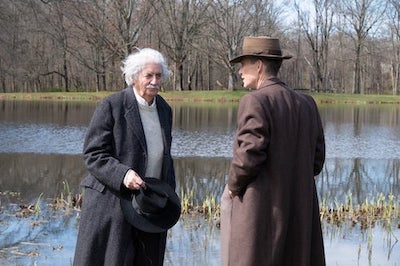
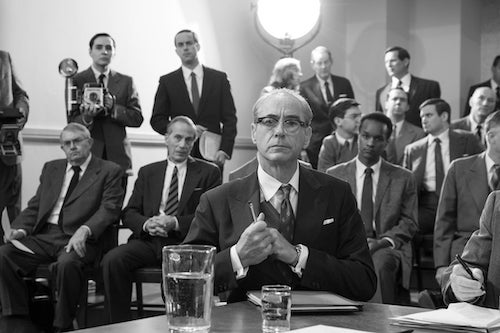
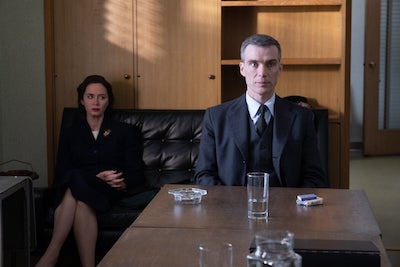
Production Design by Ruth De Jong is so detailed, you’ll feel surrounded by
the time and place. Cinematographer Hoyte Van Hoytema gets so close to the faces you can not only see, but feel, the turmoil boiling under the surface, especially well seen in Murphy, Blunt and Downy, Jr. There is also a slight granular texture to the film that helps put the viewer back in the 40’s and 50’s to look more that time period. Nolan gave some consideration to de-aging Murphy for scenes in his youth, which the director ultimately rejected as well as for using CGI anywhere, even for the horrifically bright, massive explosion of the bomb that uses light and sound for the greatest effect..
Nolan adds abstract scenes of molecules bouncing, clouds or stars floating in the sky, flames raging, and more colorful visions indicating theories, thoughts and emotions perpetually swirling in Oppenheimer’s head. They reminded us of the ethereal visions of the universe in Terence Malick’s Tree of Life.
The music by Ludwig Göransson often uses discordant chords that amplify the tension leading up to the most serious decisions or actions. Then going completely silent when a dramatic traumatic event occurs, emphasizing the risk at hand. All very effective.
This film historically itemizes the events leading to the creation of the ultimate weapon capable of world destruction. It also reveals the tense relationships between scientists, politicians, and the military. Nolan uses his stellar cast well to show this cautionary tale of how close we may have come to blowing up our world with one push of a button. Oppenheim was eventually awarded for his work. And we think Nolan, his cast and crew may be up for some awards of their own.
Universal Pictures 3 Hours R









